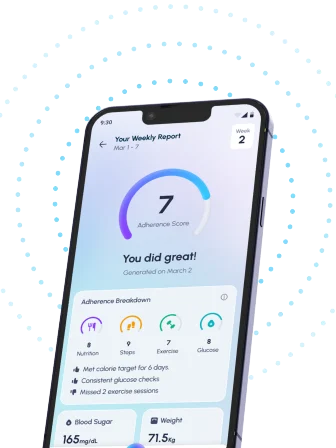Table of Contents
- Early Diabetes Detection: Key Biomarkers
- Understanding Diabetes Progression Stages
- Biomarkers for Early Diabetes Intervention: A Guide
- What Biomarkers Predict Diabetes Risk?
- Improving Diabetes Outcomes Through Early Detection
- Frequently Asked Questions
- References
Living with diabetes can feel like navigating a complex maze, but understanding its progression is the key to unlocking better management and a healthier life. This blog post focuses on Understanding Diabetes Progression: Biomarkers for Early Intervention, exploring the vital role that early detection plays in preventing serious complications. We’ll delve into the latest research on specific biomarkers that can signal the onset of diabetes, even before symptoms appear, empowering you to take proactive steps towards better health. Early intervention is crucial, and learning about these indicators could be life-changing. Let’s explore how these advancements are revolutionizing diabetes care.
Early Diabetes Detection: Key Biomarkers
Understanding the Silent Threat
India faces a significant challenge with the alarmingly high number of early-onset diabetes cases, often manifesting between the ages of 25 and 40. This underscores the urgent need for effective early detection strategies. Unlike many Western populations where type 2 diabetes typically appears later in life, the prevalence of early-onset diabetes in India and other tropical countries necessitates a proactive approach focusing on identifying key biomarkers before the onset of noticeable symptoms. Early intervention is crucial in mitigating long-term health complications. For more information on recognizing early warning signs, check out 10 Early Signs and Symptoms of Diabetes? – Tap Health.
Identifying Key Biomarkers for Early Diabetes Detection
Several biomarkers can indicate an increased risk of developing diabetes, even before a formal diagnosis. These include fasting plasma glucose (FPG) levels, which are routinely measured. Elevated levels, while not automatically indicative of diabetes, warrant further investigation. HbA1c, or glycosylated hemoglobin, provides a long-term picture of blood glucose control, offering valuable insight over several months. Measuring insulin resistance through tests like the homeostasis model assessment (HOMA-IR) can reveal how effectively the body processes glucose. C-peptide levels, a byproduct of insulin production, can help assess pancreatic function and insulin secretion. Finally, monitoring levels of certain inflammatory markers can provide additional clues, as chronic inflammation is often linked to diabetes development.
Actionable Steps for Early Detection
Individuals within the high-risk age group (25-40), particularly those with a family history of diabetes or exhibiting symptoms like increased thirst or frequent urination, should proactively discuss these biomarkers with their healthcare provider. Regular check-ups, including blood tests, are essential for early detection and subsequent management. Lifestyle modifications, including a balanced diet and regular exercise, play a vital role in preventing or delaying the onset of diabetes, especially in high-risk populations in India and other tropical regions. Early detection empowers individuals to take control of their health and significantly reduce the risk of long-term complications. Understanding the challenges of managing diabetes as you age is also important; Managing Diabetes as You Age: Challenges and Solutions offers valuable insights.
Understanding Diabetes Progression Stages
Diabetes, a growing concern globally, particularly impacts the working-age population. Data from the International Diabetes Federation reveals that a significant 61% of people with diabetes are aged between 20-64 years, highlighting its impact on productivity and economic development in regions like India and other tropical countries. Understanding the progression of diabetes is crucial for timely intervention and improved health outcomes.
Early Stages: Prediabetes and Impaired Glucose Tolerance
Early detection is key. Many individuals with prediabetes, a condition characterized by higher-than-normal blood sugar levels, remain asymptomatic. This stage often precedes type 2 diabetes and is marked by subtle changes in glucose metabolism. Regular health checkups, including fasting blood glucose and HbA1c tests, are essential for early detection, especially in high-risk populations. Lifestyle modifications, including dietary changes and increased physical activity, can often prevent or delay the onset of type 2 diabetes.
Type 1 and Type 2 Diabetes Progression
Type 1 diabetes, an autoimmune condition, develops rapidly, while type 2 diabetes is usually a gradual process. In type 2 diabetes, the body’s cells become resistant to insulin, leading to elevated blood sugar. Over time, this hyperglycemia damages various organs, including the eyes, kidneys, nerves, and heart. Monitoring blood glucose levels regularly and adhering to prescribed medication are vital in managing the disease’s progression. Understanding the link between diabetes and obesity is also crucial for prevention and management. For more information, see our blog on Understanding the Link Between Diabetes and Obesity.
Advanced Stages: Complications
Uncontrolled diabetes leads to serious complications such as diabetic retinopathy (eye damage), nephropathy (kidney damage), neuropathy (nerve damage), and cardiovascular disease. The aging population (39% of people with diabetes are 65+), prevalent in many tropical and Indian regions, faces a heightened risk of these complications. Early detection and proactive management are crucial to mitigate these risks. One significant complication involves the effect on blood flow. To learn more, read our article on How Does Diabetes Affect Blood Flow?
Regional Considerations in India and Tropical Countries
In India and many tropical countries, access to healthcare and awareness about diabetes may be limited. Promoting accessible and affordable screening programs, alongside educational initiatives targeted at high-risk groups, is vital. These programs should emphasize lifestyle modifications, early detection, and ongoing management to improve health outcomes and reduce the burden of diabetes in these regions.
Biomarkers for Early Diabetes Intervention: A Guide
Globally, the silent march of diabetes continues, with a staggering 50% of cases remaining undiagnosed, as highlighted by the International Diabetes Federation. This alarming statistic underscores the urgent need for early intervention strategies, particularly in regions like India and other tropical countries where diabetes prevalence is high. Early detection is key, and understanding specific biomarkers can significantly improve our chances of identifying individuals at risk before the onset of significant complications.
Key Biomarkers for Early Detection
Several biomarkers can indicate a predisposition to type 2 diabetes, even before clinical symptoms emerge. These include elevated fasting blood glucose levels, impaired glucose tolerance, and increased levels of HbA1c (glycated hemoglobin). Other crucial indicators include insulin resistance markers such as high levels of insulin and C-peptide, as well as markers of inflammation and oxidative stress, which are often associated with the development of diabetes. Regular monitoring of these biomarkers, especially in high-risk populations within India and other tropical nations, is crucial.
Actionable Steps for Early Intervention
In India and other tropical countries, lifestyle factors significantly contribute to diabetes risk. Regular health check-ups, including blood tests to assess these key biomarkers, are essential. Maintaining a healthy weight, engaging in regular physical activity, and adopting a balanced diet are crucial preventative measures. Early intervention, guided by biomarker analysis and proactive lifestyle changes, can significantly reduce the risk of developing type 2 diabetes and its associated complications. For more tips on managing your health after diagnosis, see our guide on 10 Proven Tips for Effective Diabetes Management. Consult your physician for personalized guidance and screening based on your individual risk profile and family history. Maintaining a strong immune system is also vital; learn more about Boosting Immunity While Managing Diabetes.
What Biomarkers Predict Diabetes Risk?
Understanding the progression of diabetes, particularly in high-risk populations like those in India and other tropical countries, is crucial for effective early intervention. Early detection significantly improves management and reduces long-term complications. Identifying predictive biomarkers is key to this process.
Genetic Predisposition and Family History
A strong family history significantly increases diabetes risk. Research shows children born to mothers with gestational diabetes are 7x more likely to develop Type 2 diabetes later in life. This highlights the importance of genetic screening and family history assessment, especially in regions with high diabetes prevalence like India. Regular blood glucose monitoring is crucial for those with a family history.
Metabolic Markers
Several metabolic markers offer valuable insights into diabetes risk. Elevated fasting blood glucose (FBG), insulin resistance, and high levels of HbA1c (glycated hemoglobin) are all strong indicators. Additionally, increased levels of triglycerides and low levels of HDL cholesterol (good cholesterol) are often observed in individuals at risk. Regular lipid profiles are recommended, particularly in individuals with a family history or other risk factors.
Lifestyle Factors and Biomarkers
While not strictly biomarkers, lifestyle factors like obesity (particularly abdominal obesity), physical inactivity, and unhealthy diet significantly influence diabetes risk and contribute to altered biomarker levels. Addressing these factors through lifestyle modifications is crucial for prevention and management. Understanding how stress impacts these factors is also important; learn more about this connection in our article on How Stress Hormones Affect Diabetes.
Access to Early Detection in India and Tropical Countries
Early detection is key to successful management. Regular health checkups, including blood glucose and lipid profile tests, are essential, especially for high-risk individuals. Access to affordable and accessible healthcare services remains a challenge in many parts of India and other tropical countries, making awareness and community-based screening programs vital. Seeking advice from your healthcare provider regarding appropriate screening schedules based on your family history and risk factors is highly recommended. It’s also important to understand the potential long-term complications, such as the relationship between diabetes and cancer; read more in our article, Does Diabetes Cause Cancer?.
Improving Diabetes Outcomes Through Early Detection
Early detection is crucial in managing diabetes, particularly in India and other tropical countries where the prevalence of Type 2 diabetes is significantly high. Studies show that up to 80% of Type 2 diabetes cases can be delayed or prevented through lifestyle modifications. This highlights the importance of focusing on early intervention strategies, leveraging readily available biomarkers and promoting proactive health management. Early detection allows for timely lifestyle changes and medical interventions, significantly improving long-term health outcomes and reducing the burden on healthcare systems.
Understanding Key Biomarkers
Several biomarkers can indicate a predisposition to developing diabetes, even before the onset of clinical symptoms. These include fasting blood glucose levels, HbA1c (glycated hemoglobin), insulin resistance markers, and C-peptide levels. Regular monitoring of these biomarkers, especially in high-risk individuals – those with a family history of diabetes, obesity, or sedentary lifestyles – is vital. In many tropical countries, access to these tests might be limited, therefore awareness campaigns and affordable screening initiatives are crucial for early detection.
Actionable Steps for Early Intervention
For individuals in India and other tropical regions, adopting a healthy lifestyle is paramount. This includes maintaining a balanced diet rich in fruits, vegetables, and whole grains, and integrating regular physical activity into daily routines. Furthermore, managing stress levels and getting adequate sleep contribute significantly to preventing or delaying the onset of diabetes. Regular health check-ups, including screenings for diabetes-related biomarkers, are essential steps towards proactive health management. By understanding the significance of early detection and taking proactive steps, individuals can significantly improve their chances of preventing or managing diabetes effectively. Lifestyle changes are key to preventing a large percentage of Type 2 diabetes cases. However, understanding the disease is also critical. Learning more about diabetes management can significantly improve outcomes, as discussed in How Diabetes Education Enhances Health Outcomes – Tap Health. The advancements in technology are also improving lifestyle management; check out How Can New Technological Advances Improve Diabetes Lifestyle? for more information.
Frequently Asked Questions
Q1. What are the key signs of diabetes, and how can it be detected early?
Early detection is crucial. Key biomarkers like fasting plasma glucose (FPG), HbA1c, and insulin resistance markers can identify individuals at risk, even before symptoms appear. Regular check-ups are recommended, especially for those aged 25-40 with a family history or symptoms.
Q2. What is prediabetes, and why is it important to address?
Prediabetes is characterized by elevated blood sugar and often precedes type 2 diabetes. Addressing prediabetes through lifestyle changes can help prevent or delay the onset of type 2 diabetes.
Q3. How do type 1 and type 2 diabetes differ in their progression?
Type 1 diabetes progresses rapidly, while type 2 diabetes is more gradual. Both types can lead to organ damage if left uncontrolled.
Q4. What lifestyle changes can help prevent or manage diabetes?
Lifestyle modifications are vital. A healthy diet and regular exercise play a key role in both preventing and managing diabetes.
Q5. What challenges exist in early diabetes detection, particularly in regions like India?
Limited healthcare access and the cost of screening programs pose significant challenges to early detection and management of diabetes in many regions, including India and other tropical countries with high rates of early-onset cases.
References
- A Practical Guide to Integrated Type 2 Diabetes Care: https://www.hse.ie/eng/services/list/2/primarycare/east-coast-diabetes-service/management-of-type-2-diabetes/diabetes-and-pregnancy/icgp-guide-to-integrated-type-2.pdf
- Towards Transparent and Accurate Diabetes Prediction Using Machine Learning and Explainable Artificial Intelligence : https://arxiv.org/pdf/2501.18071




